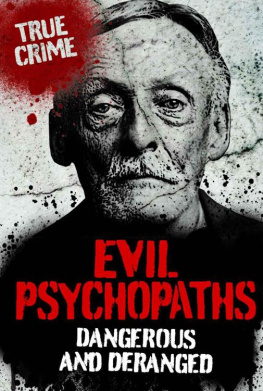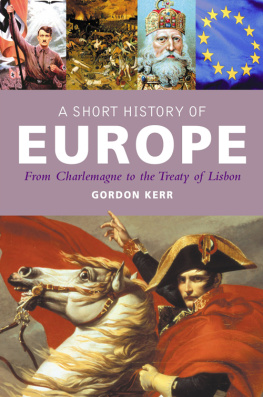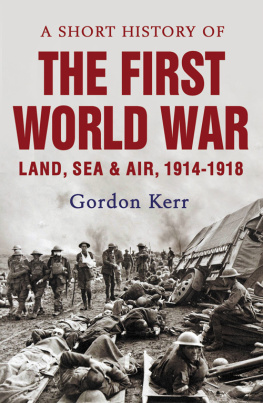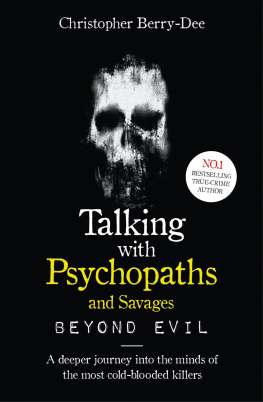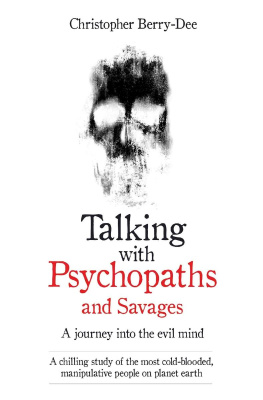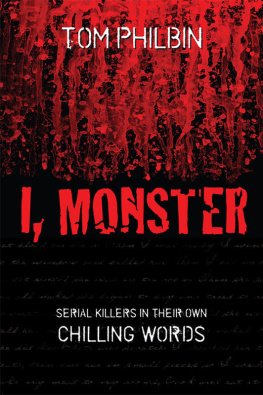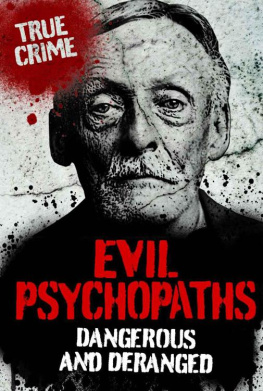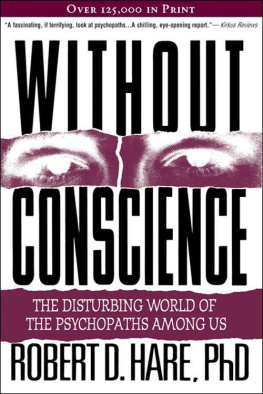

Contents

Introduction

They are different to the rest of us. While we do our level best to maintain the checks and balances that keep us civilised, there are some amongst us who do not, or cannot, have the ability to set loose the monster within with devastating and often shocking consequences. They are narcissistic, ruthless, emotionally cold, cruel, vicious, self-seeking, easily bored men and women who are totally uninhibited in the methods by which they achieve their goals. But at the same time, they can be charm itself, capable, very often, of manipulating people into doing or believing things they would never dream of. What other explanation could there be for the mass hysteria created by Adolf Hitler before and during World War II, when an entire nation took part in horrific acts of cruelty and mass murder? Pol Pots depraved regime in Cambodia in the 1970s, when hundreds of thousands of Cambodians were killed, provides another example of an entire country being manipulated into carrying out unspeakable acts. Or how do you explain Myra Hindleys chilling compliance with whatever her lover Ian Brady demanded of her graduating from posing for pornographic photographs to helping him to find children on whom he could work out his depraved fantasies? Gilles de Rais, a powerful man in 15th century France, seems to have had little trouble in recruiting a whole team of accomplices who helped him to find innocent children to be the victims of his cruel games.
The psychopath often does not kill for financial gain or improvement. He or she does it simply because it provides psychological gratification, or, as notorious serial killer and psychopath Ted Bundy put it shortly before his execution: Im the most cold-blooded sonofabitch youll ever meet I just liked to kill, I wanted to kill. Dr Thomas Neil Cream did not even have to be present when his victims succumbed to the potions and pills he doled out to them. The simple knowledge that they were going to die was enough for him.
Others try to explain their acts away by citing voices in their heads, as in the case of John Lynch, the Berrima Axe-murderer, or attempt to justify their acts as some kind of moral crusade. The Yorkshire Ripper, Peter Sutcliffe, claimed to be cleaning up the streets by killing thirteen prostitutes, while John Wayne Gacy, killer of thirty-three boys and men in the 1970s, described his victims as worthless little queers and punks. There is little doubt that the legendary Jack the Ripper was also on some kind of moral crusade, cleaning up the squalid streets of 19th century Whitechapel in Londons East End. John Reginald Christie, the murderous strangler of 10 Rillington Place seemed to be on a mission to exorcise his hatred for women, a mission he shared with the famous Night Stalker, Richard Ramirez, the rapist, sodomiser and gruesome serial killer of women, whose victims died smelling his foul breath, gained from eating an excess of junk food during the neglect of his childhood.
Of course, some do gain from their acts. John George Haigh, the Acid Bath Murderer killed people for their bank accounts or property before giving them a hot bath, but his behaviour was that of a psychopath who belived he was invincible, somehow above the law. Unfortunately for him, he was just not quite insane enough to escape the gallows. Velma Barfield, Nannie Doss and Mary Ann Cotton, the famous women serial poisoners killed in the main to benefit from insurance policies, but there is no denying that they also killed for themselves, because their victims stood in the way of their happiness, something that is unwise around a psychopath.
Some are, however, beyond the pale. How can you account for the sick acts and behaviour of men such as Dennis Nilsen, Robert Black, Ian Brady, John Wayne Gacy, Ed Gein or Patrick Mackay? These are men whose actions place them outside of society with little chance of finding their way back in. For them, killing was an act to be enjoyed, to take pleasure from and to do again and again until they were stopped. Other lives did not matter. For Dennis Nilsen, for instance, killing was all about him and his terrible loneliness. He never at any moment stopped to consider the life he had snuffed out. Neither did Patrick Mackay, very often killing and staying for a while in the house of the person he had killed, listening to the radio or watching television.
Ultimately, their pleasure and gratification is all that matters. Peter Kurten, the Vampire of Dusseldorf, as he was known, loved killing and gained sexual gratification from it, achieving orgasm when he poured petrol over one of his numerous victims and set it on fire. Patrick Mackay talked about the erotic nature of a wound he had inflicted on a priest who was dying in front of him. He also spoke about how euphoric he felt after killing, a feeling that would remain with him for several days.
How did they become monsters? Of course, some were just born that way, but it is interesting how many of the killers in this book were born to a life of abuse, anger and neglect. Peter Kurtens father would rape the mother of his thirteen children in front of them; he would also rape his daughters. The stepfather of Aileen Wuornos became a psychopathic child molestor who would eventually hang himself in prison. Velma Barfield was beaten by a drunken disciplinarian of a father. Richard Speck had an abusive stepfather and Ed Gein lived in a rigidly disciplined religious household where his mother did not allow him or his brother to cultivate friendships and spent afternoons reading the Bible to them. All of these negative experiences were stored away by these men and women, either to be copied when they got older or to be avenged.
Evil Psychopaths examines the excesses to which some peoples demons will drive them and examines the lives of psychopaths, their motivations, their methods and the journeys their lives took to the fatal moment when they found that they enjoyed no greater pleasure than taking another life.
Part One: Psychopathic Killers In History
Emperor Nero

He was quite simply a megalomaniac from a long line of psychopaths.
His grandfather led the way. Lucius Domitius Ahenobarbus had been savage and cruel. The gladiatorial contests he organised were so bloody and vicious that the Emperor Augustus had to ask him to tone things down a little. His father, Gnaeus, once rode his horse over a small child on the Appian Way, the road connecting Rome with southeast Italy, just for fun. He was also reported to have gouged out a mans eyes for criticising him and killed another man for not drinking as much as he had been ordered to. Gnaeus lived a debauched life, he was a serial adulterer and enjoyed an incestuous relationship with his sister, Domitia Lepida. He was known to defraud bankers and when he occupied the important position of Praetor, Nero made a habit of swindling charioteers, victorious in the games, of their prize money. The great Roman historian, Suetonius, described him as despicable and dishonest.
Neros mother, Agrippina, great granddaughter of Emperor Augustus, also came from a troubled background. Born during the reign of the tyrannical Emperor Tiberius, she witnessed her two brothers starved to death by order of Tiberius. To make matters worse, not only did she have her first sexual experience at the age of twelve, but it was with her surviving brother, the future emperor, Caligula. In 39, Agrippina and her sister, Julia Livilla were discovered to be involved in a plot to murder Caligula and replace him with their late sister Drusillas widower, Marcus Aemilius Lepidus. Lepidus was executed and the two women were sent into exile on the Pontine Islands where they had to dive for sponges to earn a living. Neros first few years, therefore, were spent in relative poverty. Meanwhile Gnaeus died when Nero was three, thus escaping trial for treason, incest and adultery.
Next page
